Marketing Audit: Target Australia's Market Analysis
VerifiedAdded on 2023/04/21
|13
|2654
|442
Report
AI Summary
This report provides a comprehensive market analysis of Target Australia, examining its performance in the retail industry. The analysis begins with an overview of Target Australia, a major departmental store chain, and its evolution. It then delves into the company's growth, profitability, and the influence of the macro environment, including political, economic, social, technological, environmental, and legal factors (PESTLE analysis). The report identifies Target's major market segments, distinguishing between primary and secondary target markets, and discusses the level of consumer involvement in decision-making. A significant portion of the report is dedicated to the competitive landscape, comparing Target with key competitors like JcPenney and Macy's, highlighting their respective strengths and weaknesses. Finally, the report concludes with a market positioning analysis, considering the primary segment, consumer involvement, and competitive dynamics to create a strategic positioning map for Target Australia.
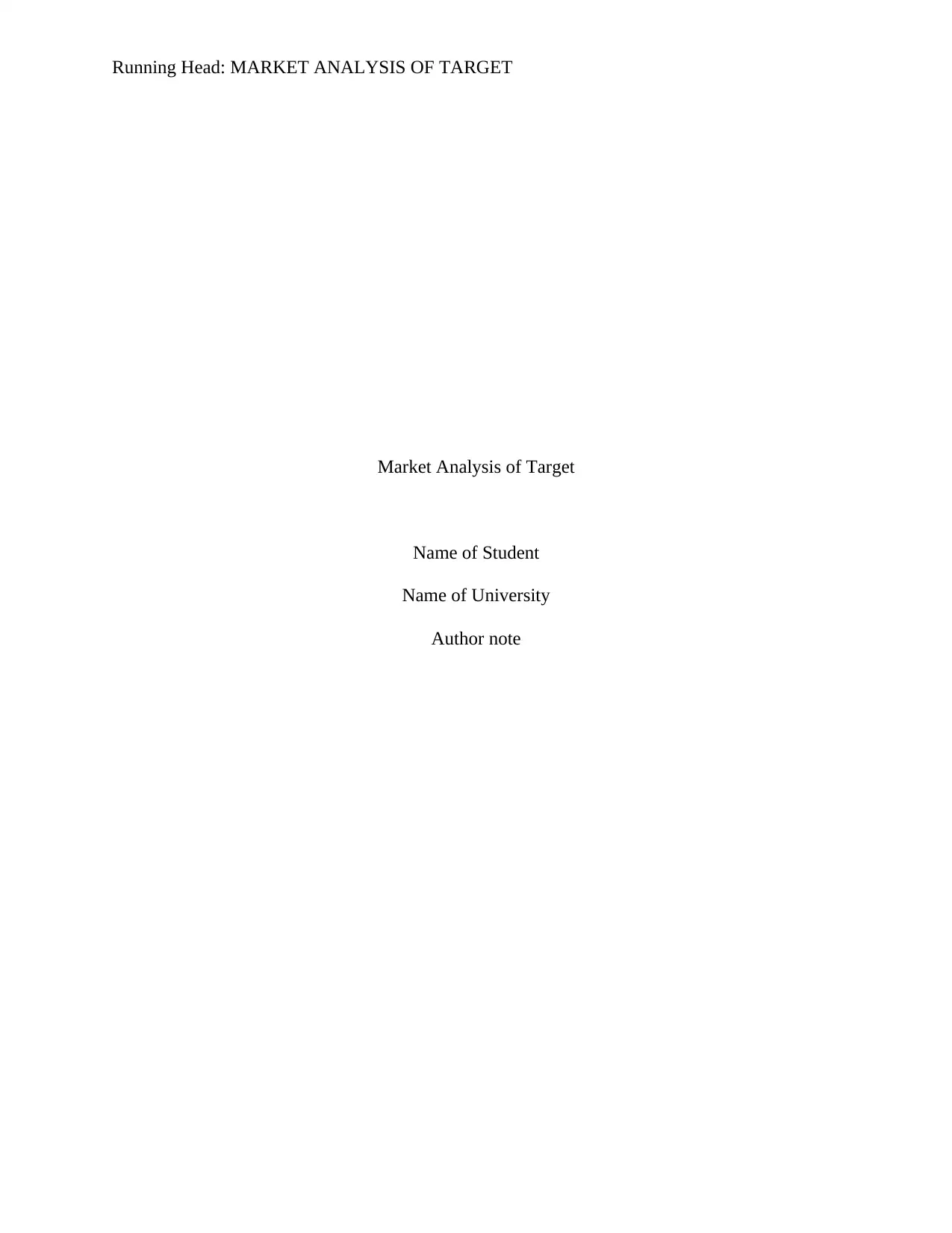
Running Head: MARKET ANALYSIS OF TARGET
Market Analysis of Target
Name of Student
Name of University
Author note
Market Analysis of Target
Name of Student
Name of University
Author note
Paraphrase This Document
Need a fresh take? Get an instant paraphrase of this document with our AI Paraphraser
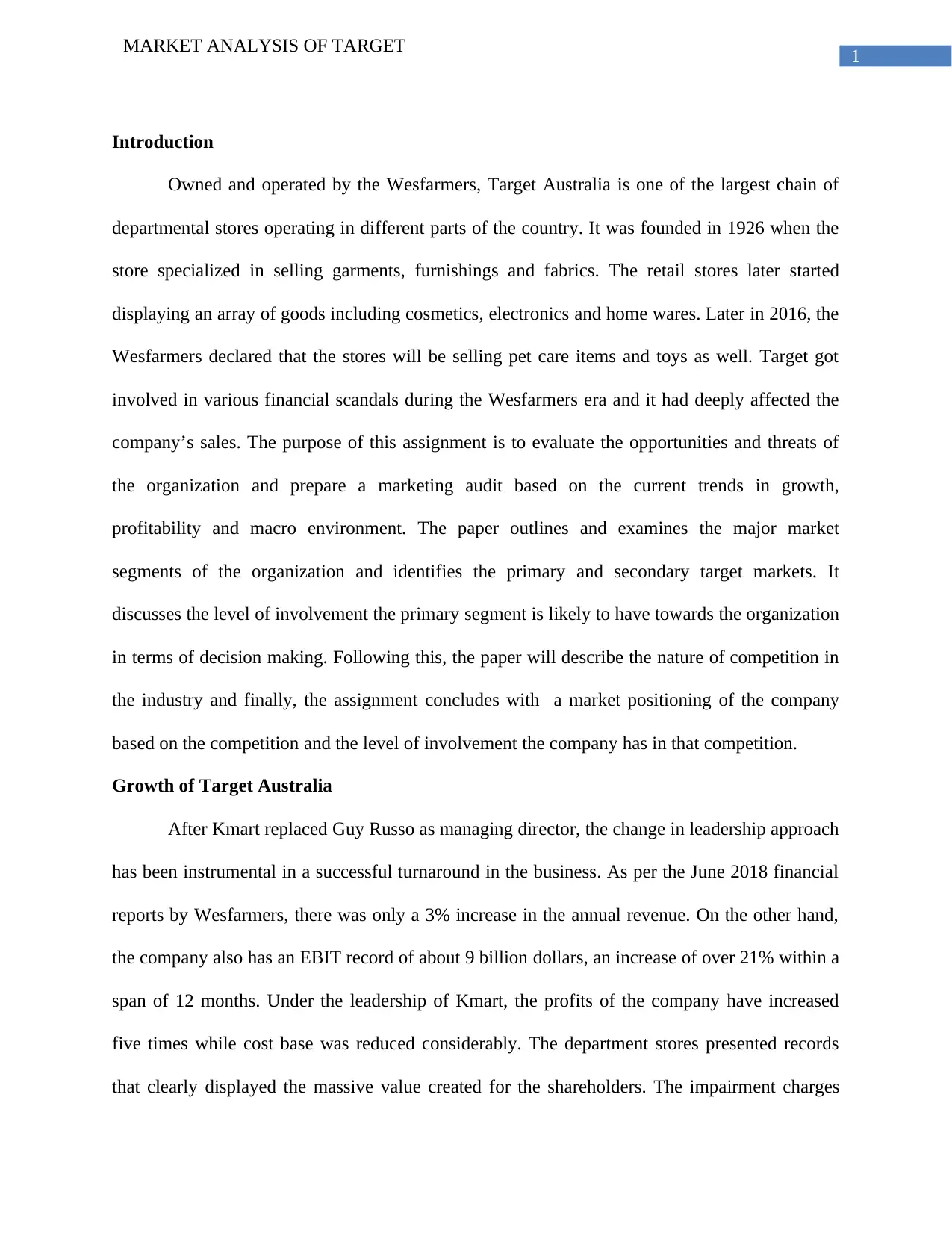
1
MARKET ANALYSIS OF TARGET
Introduction
Owned and operated by the Wesfarmers, Target Australia is one of the largest chain of
departmental stores operating in different parts of the country. It was founded in 1926 when the
store specialized in selling garments, furnishings and fabrics. The retail stores later started
displaying an array of goods including cosmetics, electronics and home wares. Later in 2016, the
Wesfarmers declared that the stores will be selling pet care items and toys as well. Target got
involved in various financial scandals during the Wesfarmers era and it had deeply affected the
company’s sales. The purpose of this assignment is to evaluate the opportunities and threats of
the organization and prepare a marketing audit based on the current trends in growth,
profitability and macro environment. The paper outlines and examines the major market
segments of the organization and identifies the primary and secondary target markets. It
discusses the level of involvement the primary segment is likely to have towards the organization
in terms of decision making. Following this, the paper will describe the nature of competition in
the industry and finally, the assignment concludes with a market positioning of the company
based on the competition and the level of involvement the company has in that competition.
Growth of Target Australia
After Kmart replaced Guy Russo as managing director, the change in leadership approach
has been instrumental in a successful turnaround in the business. As per the June 2018 financial
reports by Wesfarmers, there was only a 3% increase in the annual revenue. On the other hand,
the company also has an EBIT record of about 9 billion dollars, an increase of over 21% within a
span of 12 months. Under the leadership of Kmart, the profits of the company have increased
five times while cost base was reduced considerably. The department stores presented records
that clearly displayed the massive value created for the shareholders. The impairment charges
MARKET ANALYSIS OF TARGET
Introduction
Owned and operated by the Wesfarmers, Target Australia is one of the largest chain of
departmental stores operating in different parts of the country. It was founded in 1926 when the
store specialized in selling garments, furnishings and fabrics. The retail stores later started
displaying an array of goods including cosmetics, electronics and home wares. Later in 2016, the
Wesfarmers declared that the stores will be selling pet care items and toys as well. Target got
involved in various financial scandals during the Wesfarmers era and it had deeply affected the
company’s sales. The purpose of this assignment is to evaluate the opportunities and threats of
the organization and prepare a marketing audit based on the current trends in growth,
profitability and macro environment. The paper outlines and examines the major market
segments of the organization and identifies the primary and secondary target markets. It
discusses the level of involvement the primary segment is likely to have towards the organization
in terms of decision making. Following this, the paper will describe the nature of competition in
the industry and finally, the assignment concludes with a market positioning of the company
based on the competition and the level of involvement the company has in that competition.
Growth of Target Australia
After Kmart replaced Guy Russo as managing director, the change in leadership approach
has been instrumental in a successful turnaround in the business. As per the June 2018 financial
reports by Wesfarmers, there was only a 3% increase in the annual revenue. On the other hand,
the company also has an EBIT record of about 9 billion dollars, an increase of over 21% within a
span of 12 months. Under the leadership of Kmart, the profits of the company have increased
five times while cost base was reduced considerably. The department stores presented records
that clearly displayed the massive value created for the shareholders. The impairment charges
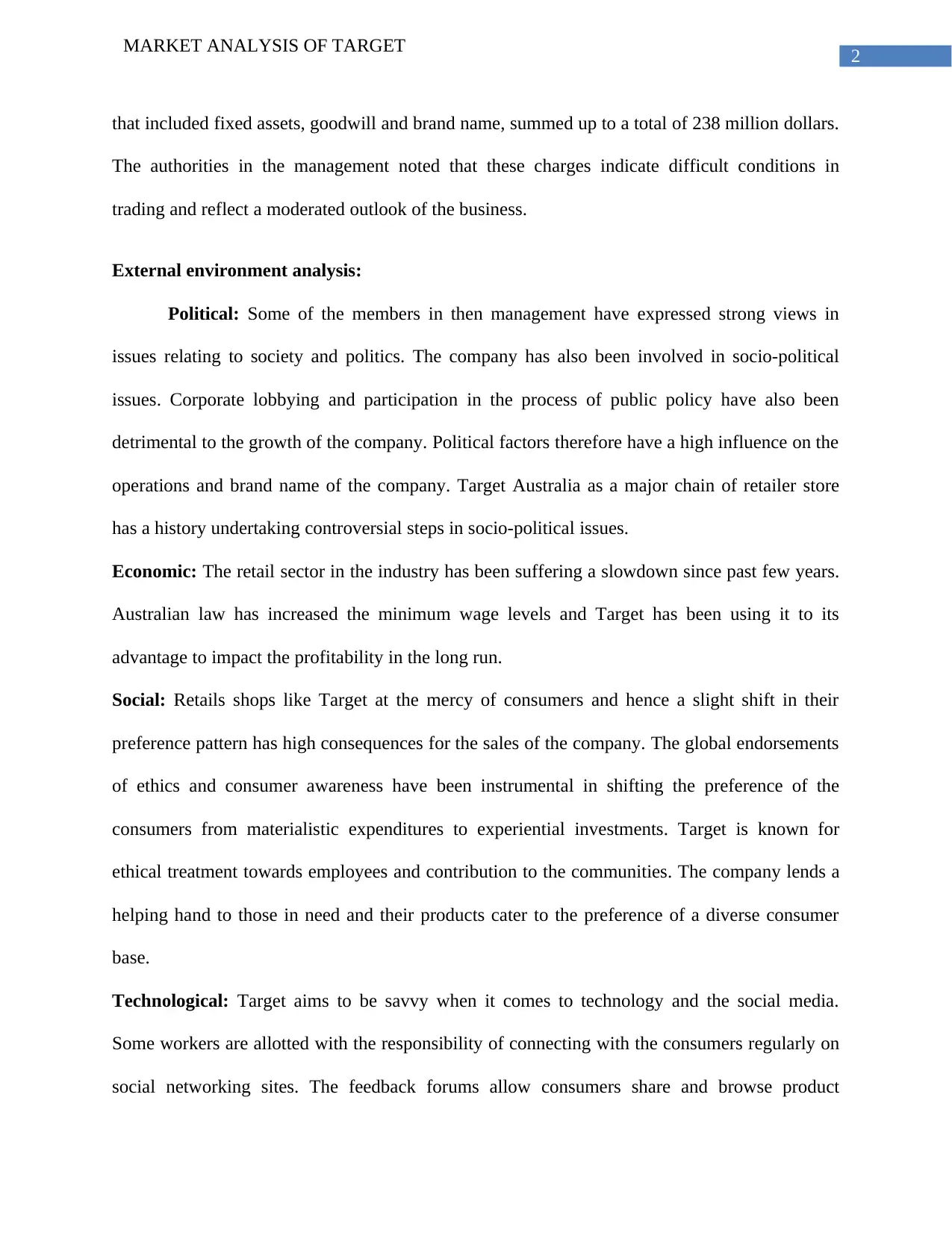
2
MARKET ANALYSIS OF TARGET
that included fixed assets, goodwill and brand name, summed up to a total of 238 million dollars.
The authorities in the management noted that these charges indicate difficult conditions in
trading and reflect a moderated outlook of the business.
External environment analysis:
Political: Some of the members in then management have expressed strong views in
issues relating to society and politics. The company has also been involved in socio-political
issues. Corporate lobbying and participation in the process of public policy have also been
detrimental to the growth of the company. Political factors therefore have a high influence on the
operations and brand name of the company. Target Australia as a major chain of retailer store
has a history undertaking controversial steps in socio-political issues.
Economic: The retail sector in the industry has been suffering a slowdown since past few years.
Australian law has increased the minimum wage levels and Target has been using it to its
advantage to impact the profitability in the long run.
Social: Retails shops like Target at the mercy of consumers and hence a slight shift in their
preference pattern has high consequences for the sales of the company. The global endorsements
of ethics and consumer awareness have been instrumental in shifting the preference of the
consumers from materialistic expenditures to experiential investments. Target is known for
ethical treatment towards employees and contribution to the communities. The company lends a
helping hand to those in need and their products cater to the preference of a diverse consumer
base.
Technological: Target aims to be savvy when it comes to technology and the social media.
Some workers are allotted with the responsibility of connecting with the consumers regularly on
social networking sites. The feedback forums allow consumers share and browse product
MARKET ANALYSIS OF TARGET
that included fixed assets, goodwill and brand name, summed up to a total of 238 million dollars.
The authorities in the management noted that these charges indicate difficult conditions in
trading and reflect a moderated outlook of the business.
External environment analysis:
Political: Some of the members in then management have expressed strong views in
issues relating to society and politics. The company has also been involved in socio-political
issues. Corporate lobbying and participation in the process of public policy have also been
detrimental to the growth of the company. Political factors therefore have a high influence on the
operations and brand name of the company. Target Australia as a major chain of retailer store
has a history undertaking controversial steps in socio-political issues.
Economic: The retail sector in the industry has been suffering a slowdown since past few years.
Australian law has increased the minimum wage levels and Target has been using it to its
advantage to impact the profitability in the long run.
Social: Retails shops like Target at the mercy of consumers and hence a slight shift in their
preference pattern has high consequences for the sales of the company. The global endorsements
of ethics and consumer awareness have been instrumental in shifting the preference of the
consumers from materialistic expenditures to experiential investments. Target is known for
ethical treatment towards employees and contribution to the communities. The company lends a
helping hand to those in need and their products cater to the preference of a diverse consumer
base.
Technological: Target aims to be savvy when it comes to technology and the social media.
Some workers are allotted with the responsibility of connecting with the consumers regularly on
social networking sites. The feedback forums allow consumers share and browse product
⊘ This is a preview!⊘
Do you want full access?
Subscribe today to unlock all pages.

Trusted by 1+ million students worldwide
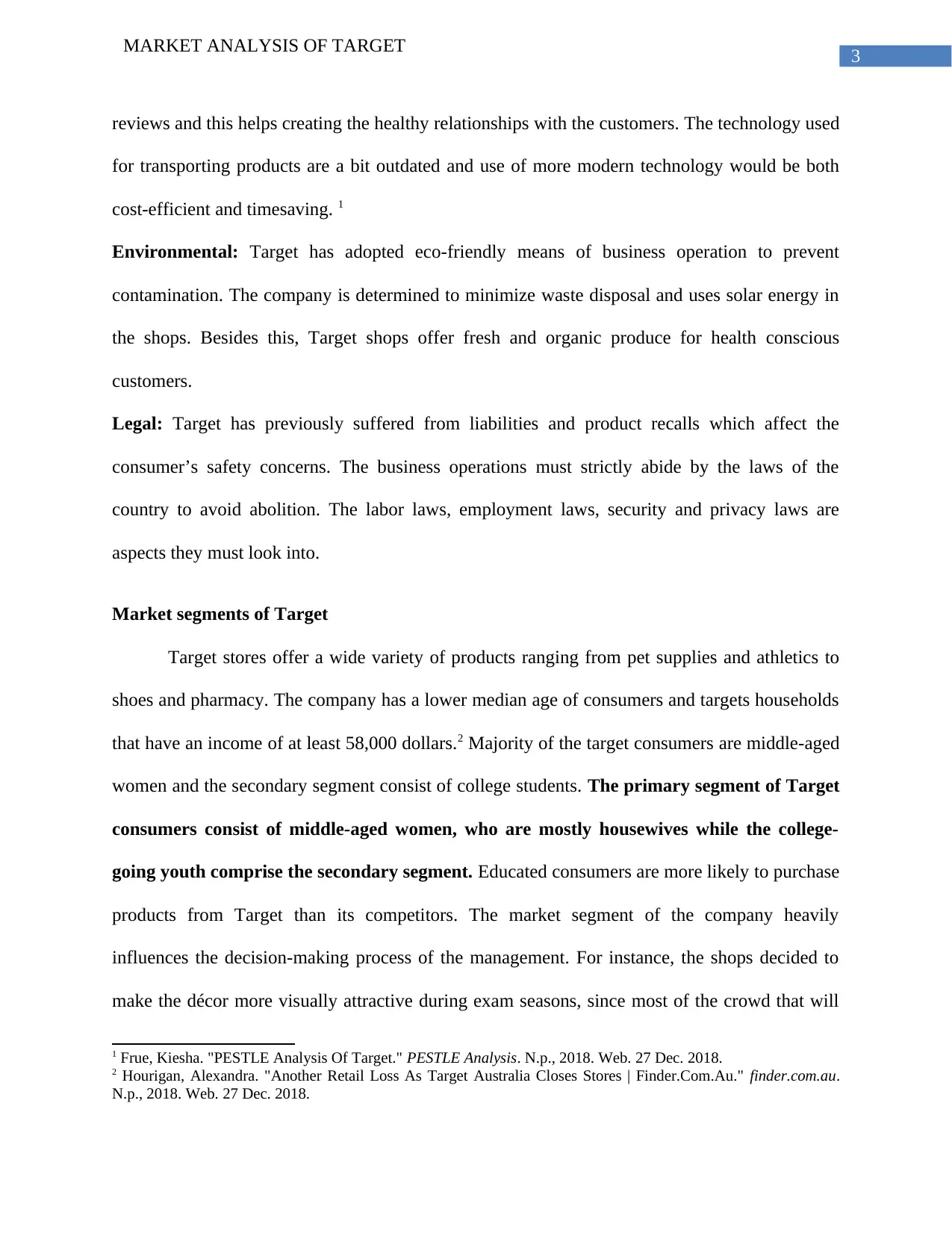
3
MARKET ANALYSIS OF TARGET
reviews and this helps creating the healthy relationships with the customers. The technology used
for transporting products are a bit outdated and use of more modern technology would be both
cost-efficient and timesaving. 1
Environmental: Target has adopted eco-friendly means of business operation to prevent
contamination. The company is determined to minimize waste disposal and uses solar energy in
the shops. Besides this, Target shops offer fresh and organic produce for health conscious
customers.
Legal: Target has previously suffered from liabilities and product recalls which affect the
consumer’s safety concerns. The business operations must strictly abide by the laws of the
country to avoid abolition. The labor laws, employment laws, security and privacy laws are
aspects they must look into.
Market segments of Target
Target stores offer a wide variety of products ranging from pet supplies and athletics to
shoes and pharmacy. The company has a lower median age of consumers and targets households
that have an income of at least 58,000 dollars.2 Majority of the target consumers are middle-aged
women and the secondary segment consist of college students. The primary segment of Target
consumers consist of middle-aged women, who are mostly housewives while the college-
going youth comprise the secondary segment. Educated consumers are more likely to purchase
products from Target than its competitors. The market segment of the company heavily
influences the decision-making process of the management. For instance, the shops decided to
make the décor more visually attractive during exam seasons, since most of the crowd that will
1 Frue, Kiesha. "PESTLE Analysis Of Target." PESTLE Analysis. N.p., 2018. Web. 27 Dec. 2018.
2 Hourigan, Alexandra. "Another Retail Loss As Target Australia Closes Stores | Finder.Com.Au." finder.com.au.
N.p., 2018. Web. 27 Dec. 2018.
MARKET ANALYSIS OF TARGET
reviews and this helps creating the healthy relationships with the customers. The technology used
for transporting products are a bit outdated and use of more modern technology would be both
cost-efficient and timesaving. 1
Environmental: Target has adopted eco-friendly means of business operation to prevent
contamination. The company is determined to minimize waste disposal and uses solar energy in
the shops. Besides this, Target shops offer fresh and organic produce for health conscious
customers.
Legal: Target has previously suffered from liabilities and product recalls which affect the
consumer’s safety concerns. The business operations must strictly abide by the laws of the
country to avoid abolition. The labor laws, employment laws, security and privacy laws are
aspects they must look into.
Market segments of Target
Target stores offer a wide variety of products ranging from pet supplies and athletics to
shoes and pharmacy. The company has a lower median age of consumers and targets households
that have an income of at least 58,000 dollars.2 Majority of the target consumers are middle-aged
women and the secondary segment consist of college students. The primary segment of Target
consumers consist of middle-aged women, who are mostly housewives while the college-
going youth comprise the secondary segment. Educated consumers are more likely to purchase
products from Target than its competitors. The market segment of the company heavily
influences the decision-making process of the management. For instance, the shops decided to
make the décor more visually attractive during exam seasons, since most of the crowd that will
1 Frue, Kiesha. "PESTLE Analysis Of Target." PESTLE Analysis. N.p., 2018. Web. 27 Dec. 2018.
2 Hourigan, Alexandra. "Another Retail Loss As Target Australia Closes Stores | Finder.Com.Au." finder.com.au.
N.p., 2018. Web. 27 Dec. 2018.
Paraphrase This Document
Need a fresh take? Get an instant paraphrase of this document with our AI Paraphraser
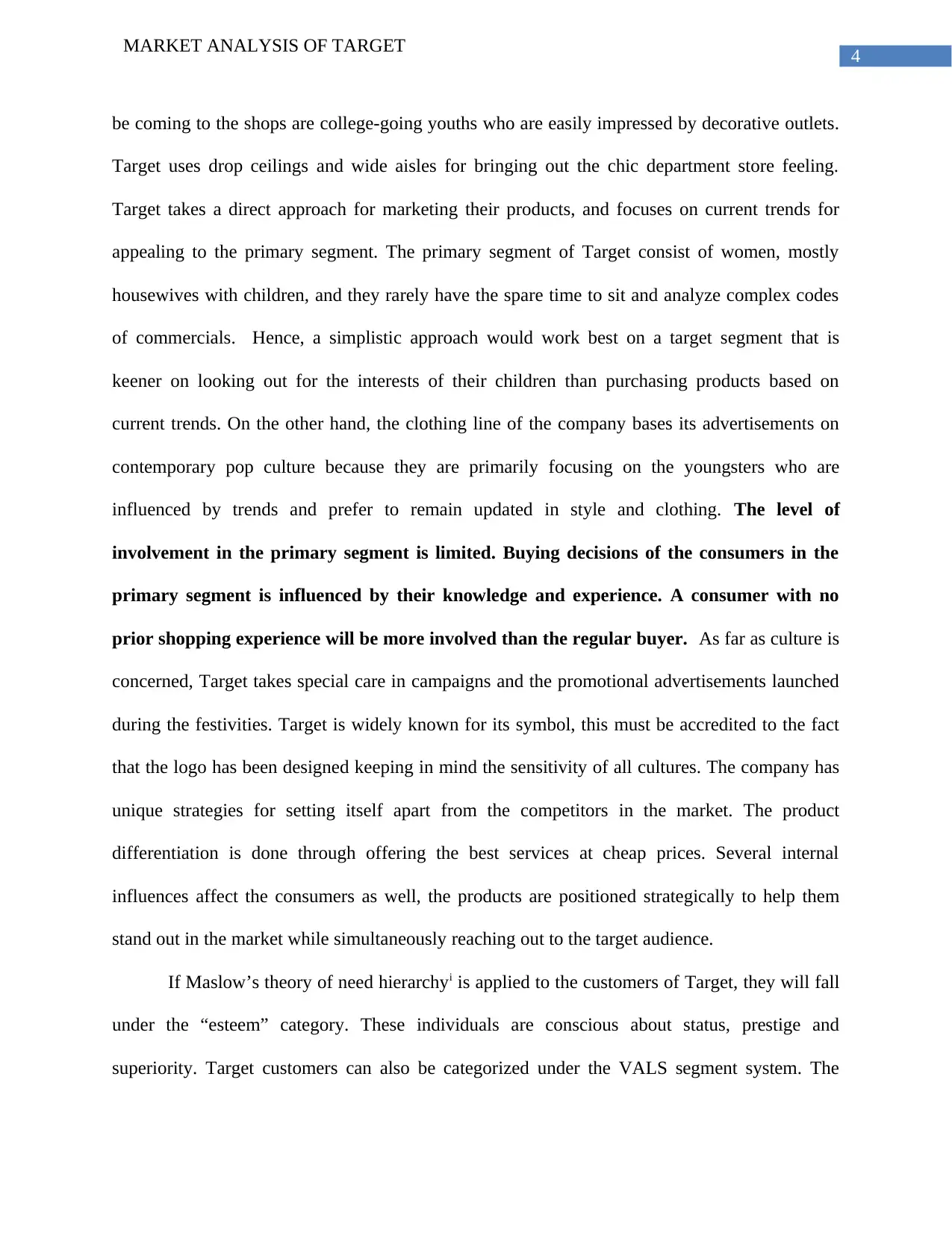
4
MARKET ANALYSIS OF TARGET
be coming to the shops are college-going youths who are easily impressed by decorative outlets.
Target uses drop ceilings and wide aisles for bringing out the chic department store feeling.
Target takes a direct approach for marketing their products, and focuses on current trends for
appealing to the primary segment. The primary segment of Target consist of women, mostly
housewives with children, and they rarely have the spare time to sit and analyze complex codes
of commercials. Hence, a simplistic approach would work best on a target segment that is
keener on looking out for the interests of their children than purchasing products based on
current trends. On the other hand, the clothing line of the company bases its advertisements on
contemporary pop culture because they are primarily focusing on the youngsters who are
influenced by trends and prefer to remain updated in style and clothing. The level of
involvement in the primary segment is limited. Buying decisions of the consumers in the
primary segment is influenced by their knowledge and experience. A consumer with no
prior shopping experience will be more involved than the regular buyer. As far as culture is
concerned, Target takes special care in campaigns and the promotional advertisements launched
during the festivities. Target is widely known for its symbol, this must be accredited to the fact
that the logo has been designed keeping in mind the sensitivity of all cultures. The company has
unique strategies for setting itself apart from the competitors in the market. The product
differentiation is done through offering the best services at cheap prices. Several internal
influences affect the consumers as well, the products are positioned strategically to help them
stand out in the market while simultaneously reaching out to the target audience.
If Maslow’s theory of need hierarchyi is applied to the customers of Target, they will fall
under the “esteem” category. These individuals are conscious about status, prestige and
superiority. Target customers can also be categorized under the VALS segment system. The
MARKET ANALYSIS OF TARGET
be coming to the shops are college-going youths who are easily impressed by decorative outlets.
Target uses drop ceilings and wide aisles for bringing out the chic department store feeling.
Target takes a direct approach for marketing their products, and focuses on current trends for
appealing to the primary segment. The primary segment of Target consist of women, mostly
housewives with children, and they rarely have the spare time to sit and analyze complex codes
of commercials. Hence, a simplistic approach would work best on a target segment that is
keener on looking out for the interests of their children than purchasing products based on
current trends. On the other hand, the clothing line of the company bases its advertisements on
contemporary pop culture because they are primarily focusing on the youngsters who are
influenced by trends and prefer to remain updated in style and clothing. The level of
involvement in the primary segment is limited. Buying decisions of the consumers in the
primary segment is influenced by their knowledge and experience. A consumer with no
prior shopping experience will be more involved than the regular buyer. As far as culture is
concerned, Target takes special care in campaigns and the promotional advertisements launched
during the festivities. Target is widely known for its symbol, this must be accredited to the fact
that the logo has been designed keeping in mind the sensitivity of all cultures. The company has
unique strategies for setting itself apart from the competitors in the market. The product
differentiation is done through offering the best services at cheap prices. Several internal
influences affect the consumers as well, the products are positioned strategically to help them
stand out in the market while simultaneously reaching out to the target audience.
If Maslow’s theory of need hierarchyi is applied to the customers of Target, they will fall
under the “esteem” category. These individuals are conscious about status, prestige and
superiority. Target customers can also be categorized under the VALS segment system. The
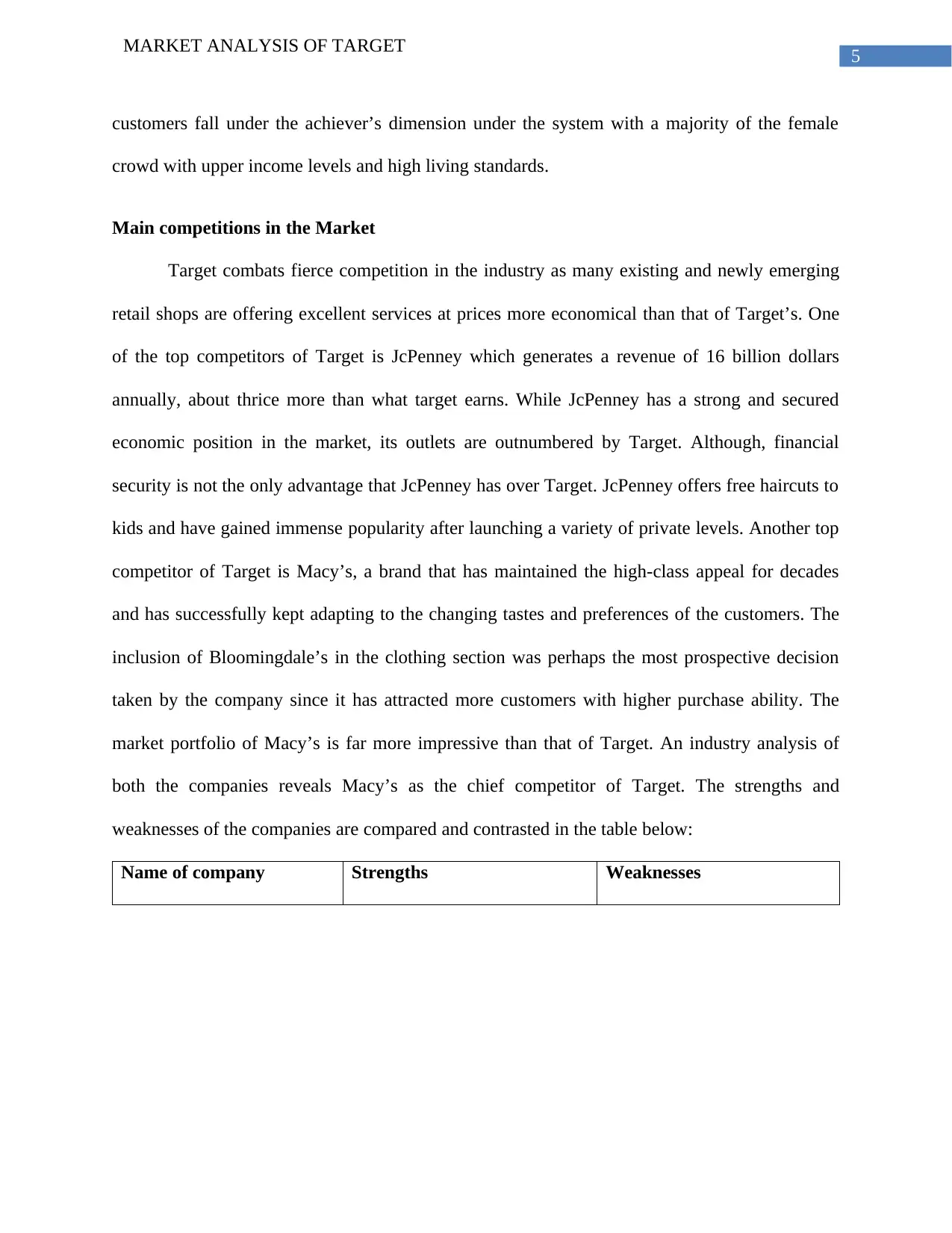
5
MARKET ANALYSIS OF TARGET
customers fall under the achiever’s dimension under the system with a majority of the female
crowd with upper income levels and high living standards.
Main competitions in the Market
Target combats fierce competition in the industry as many existing and newly emerging
retail shops are offering excellent services at prices more economical than that of Target’s. One
of the top competitors of Target is JcPenney which generates a revenue of 16 billion dollars
annually, about thrice more than what target earns. While JcPenney has a strong and secured
economic position in the market, its outlets are outnumbered by Target. Although, financial
security is not the only advantage that JcPenney has over Target. JcPenney offers free haircuts to
kids and have gained immense popularity after launching a variety of private levels. Another top
competitor of Target is Macy’s, a brand that has maintained the high-class appeal for decades
and has successfully kept adapting to the changing tastes and preferences of the customers. The
inclusion of Bloomingdale’s in the clothing section was perhaps the most prospective decision
taken by the company since it has attracted more customers with higher purchase ability. The
market portfolio of Macy’s is far more impressive than that of Target. An industry analysis of
both the companies reveals Macy’s as the chief competitor of Target. The strengths and
weaknesses of the companies are compared and contrasted in the table below:
Name of company Strengths Weaknesses
MARKET ANALYSIS OF TARGET
customers fall under the achiever’s dimension under the system with a majority of the female
crowd with upper income levels and high living standards.
Main competitions in the Market
Target combats fierce competition in the industry as many existing and newly emerging
retail shops are offering excellent services at prices more economical than that of Target’s. One
of the top competitors of Target is JcPenney which generates a revenue of 16 billion dollars
annually, about thrice more than what target earns. While JcPenney has a strong and secured
economic position in the market, its outlets are outnumbered by Target. Although, financial
security is not the only advantage that JcPenney has over Target. JcPenney offers free haircuts to
kids and have gained immense popularity after launching a variety of private levels. Another top
competitor of Target is Macy’s, a brand that has maintained the high-class appeal for decades
and has successfully kept adapting to the changing tastes and preferences of the customers. The
inclusion of Bloomingdale’s in the clothing section was perhaps the most prospective decision
taken by the company since it has attracted more customers with higher purchase ability. The
market portfolio of Macy’s is far more impressive than that of Target. An industry analysis of
both the companies reveals Macy’s as the chief competitor of Target. The strengths and
weaknesses of the companies are compared and contrasted in the table below:
Name of company Strengths Weaknesses
⊘ This is a preview!⊘
Do you want full access?
Subscribe today to unlock all pages.

Trusted by 1+ million students worldwide
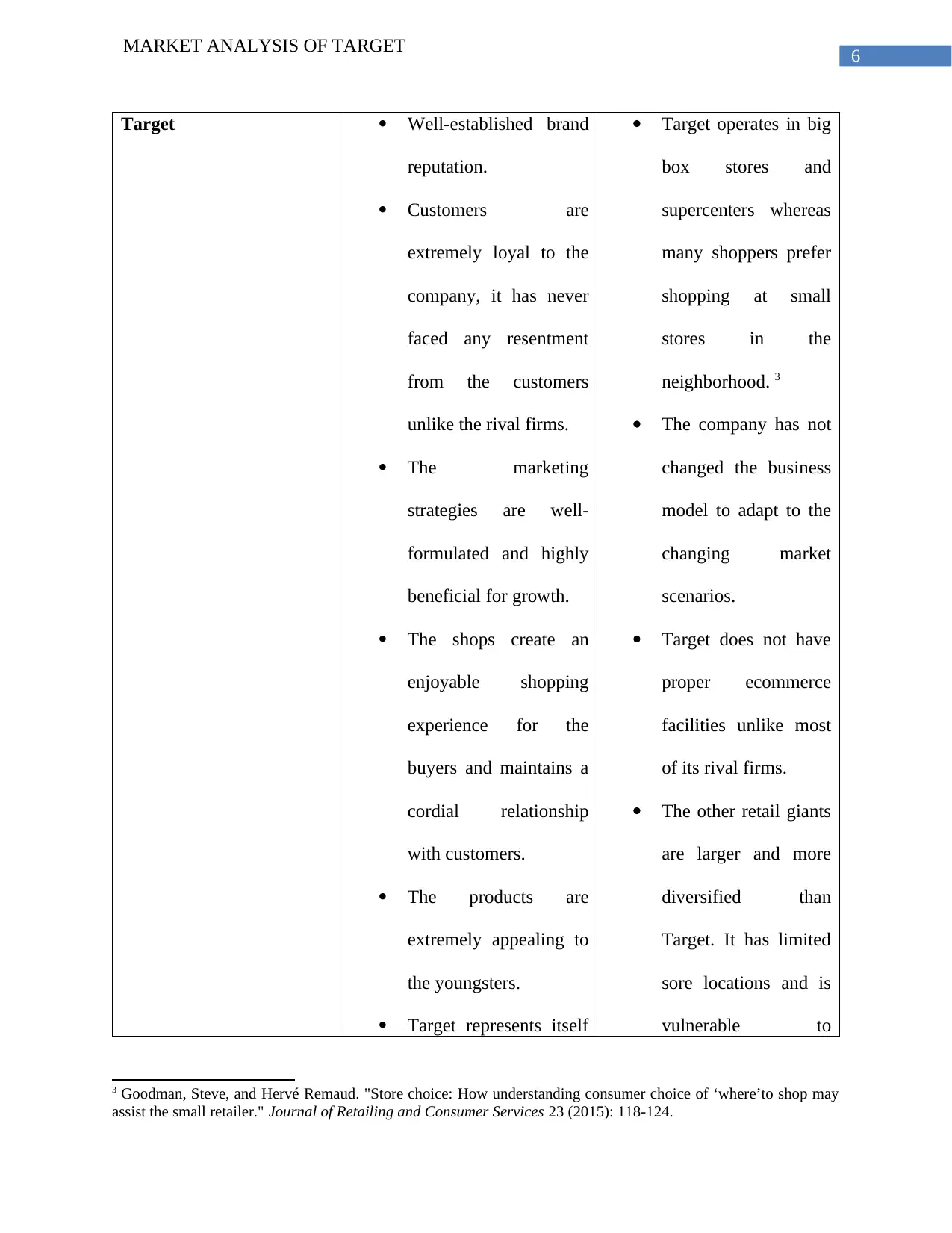
6
MARKET ANALYSIS OF TARGET
Target Well-established brand
reputation.
Customers are
extremely loyal to the
company, it has never
faced any resentment
from the customers
unlike the rival firms.
The marketing
strategies are well-
formulated and highly
beneficial for growth.
The shops create an
enjoyable shopping
experience for the
buyers and maintains a
cordial relationship
with customers.
The products are
extremely appealing to
the youngsters.
Target represents itself
Target operates in big
box stores and
supercenters whereas
many shoppers prefer
shopping at small
stores in the
neighborhood. 3
The company has not
changed the business
model to adapt to the
changing market
scenarios.
Target does not have
proper ecommerce
facilities unlike most
of its rival firms.
The other retail giants
are larger and more
diversified than
Target. It has limited
sore locations and is
vulnerable to
3 Goodman, Steve, and Hervé Remaud. "Store choice: How understanding consumer choice of ‘where’to shop may
assist the small retailer." Journal of Retailing and Consumer Services 23 (2015): 118-124.
MARKET ANALYSIS OF TARGET
Target Well-established brand
reputation.
Customers are
extremely loyal to the
company, it has never
faced any resentment
from the customers
unlike the rival firms.
The marketing
strategies are well-
formulated and highly
beneficial for growth.
The shops create an
enjoyable shopping
experience for the
buyers and maintains a
cordial relationship
with customers.
The products are
extremely appealing to
the youngsters.
Target represents itself
Target operates in big
box stores and
supercenters whereas
many shoppers prefer
shopping at small
stores in the
neighborhood. 3
The company has not
changed the business
model to adapt to the
changing market
scenarios.
Target does not have
proper ecommerce
facilities unlike most
of its rival firms.
The other retail giants
are larger and more
diversified than
Target. It has limited
sore locations and is
vulnerable to
3 Goodman, Steve, and Hervé Remaud. "Store choice: How understanding consumer choice of ‘where’to shop may
assist the small retailer." Journal of Retailing and Consumer Services 23 (2015): 118-124.
Paraphrase This Document
Need a fresh take? Get an instant paraphrase of this document with our AI Paraphraser
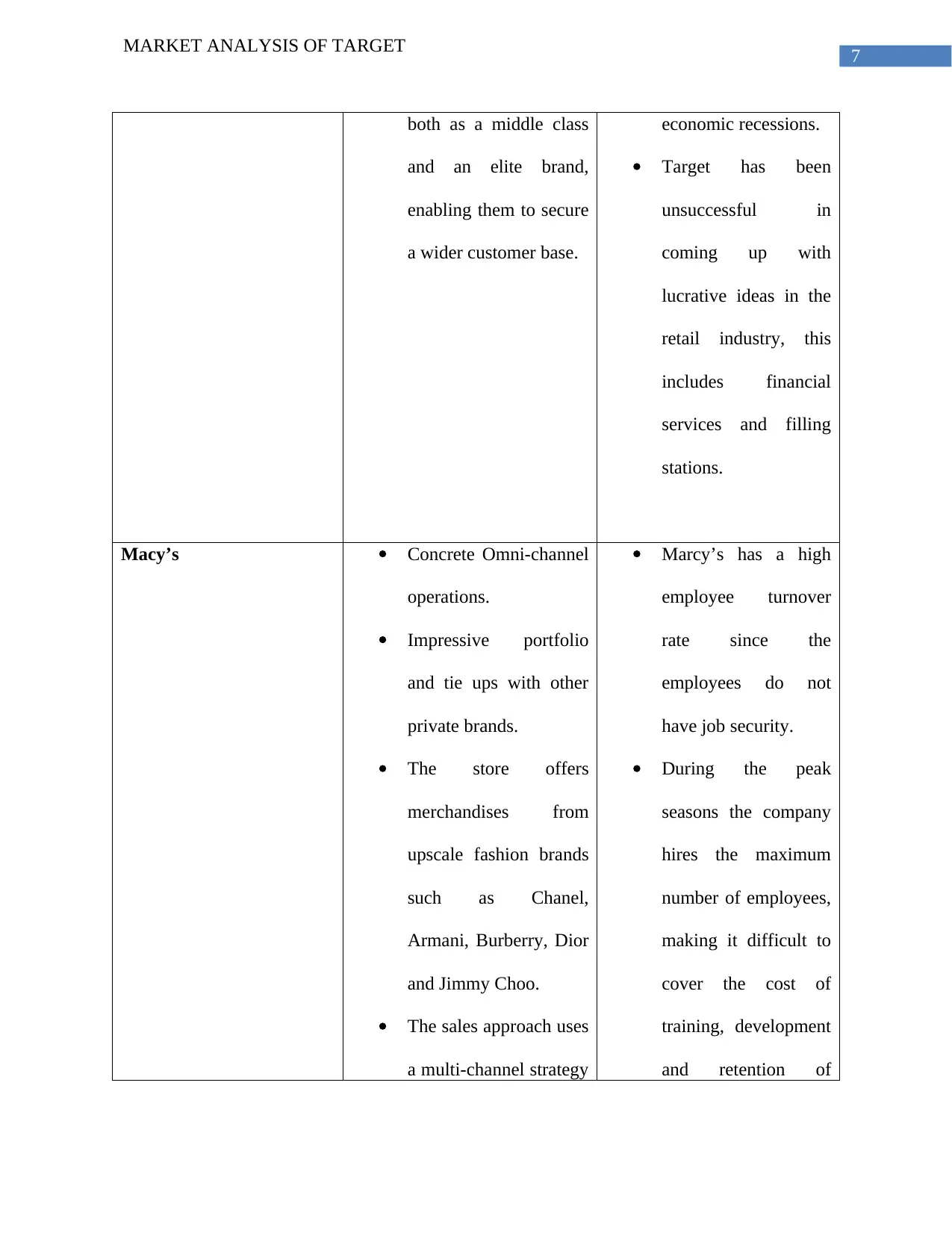
7
MARKET ANALYSIS OF TARGET
both as a middle class
and an elite brand,
enabling them to secure
a wider customer base.
economic recessions.
Target has been
unsuccessful in
coming up with
lucrative ideas in the
retail industry, this
includes financial
services and filling
stations.
Macy’s Concrete Omni-channel
operations.
Impressive portfolio
and tie ups with other
private brands.
The store offers
merchandises from
upscale fashion brands
such as Chanel,
Armani, Burberry, Dior
and Jimmy Choo.
The sales approach uses
a multi-channel strategy
Marcy’s has a high
employee turnover
rate since the
employees do not
have job security.
During the peak
seasons the company
hires the maximum
number of employees,
making it difficult to
cover the cost of
training, development
and retention of
MARKET ANALYSIS OF TARGET
both as a middle class
and an elite brand,
enabling them to secure
a wider customer base.
economic recessions.
Target has been
unsuccessful in
coming up with
lucrative ideas in the
retail industry, this
includes financial
services and filling
stations.
Macy’s Concrete Omni-channel
operations.
Impressive portfolio
and tie ups with other
private brands.
The store offers
merchandises from
upscale fashion brands
such as Chanel,
Armani, Burberry, Dior
and Jimmy Choo.
The sales approach uses
a multi-channel strategy
Marcy’s has a high
employee turnover
rate since the
employees do not
have job security.
During the peak
seasons the company
hires the maximum
number of employees,
making it difficult to
cover the cost of
training, development
and retention of
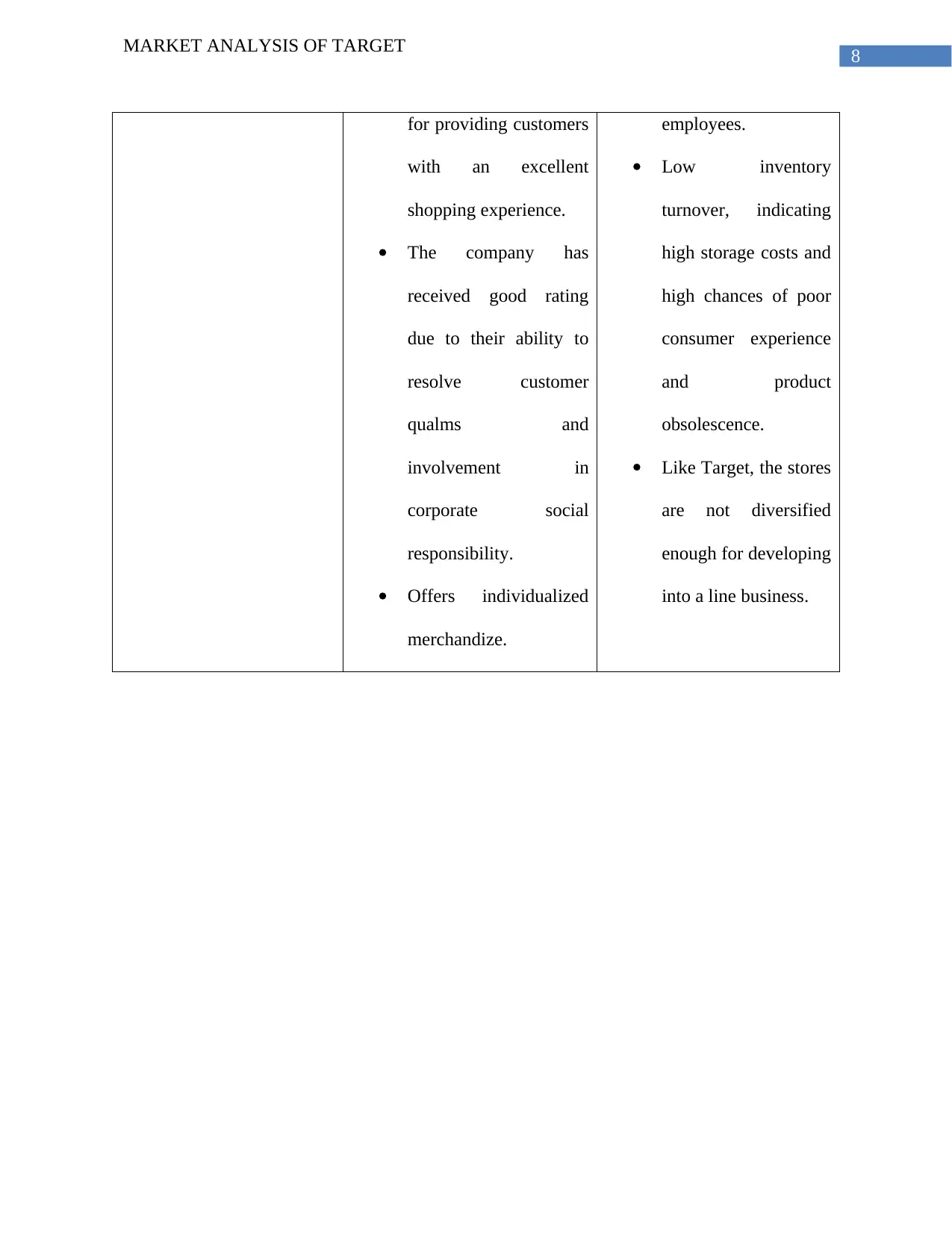
8
MARKET ANALYSIS OF TARGET
for providing customers
with an excellent
shopping experience.
The company has
received good rating
due to their ability to
resolve customer
qualms and
involvement in
corporate social
responsibility.
Offers individualized
merchandize.
employees.
Low inventory
turnover, indicating
high storage costs and
high chances of poor
consumer experience
and product
obsolescence.
Like Target, the stores
are not diversified
enough for developing
into a line business.
MARKET ANALYSIS OF TARGET
for providing customers
with an excellent
shopping experience.
The company has
received good rating
due to their ability to
resolve customer
qualms and
involvement in
corporate social
responsibility.
Offers individualized
merchandize.
employees.
Low inventory
turnover, indicating
high storage costs and
high chances of poor
consumer experience
and product
obsolescence.
Like Target, the stores
are not diversified
enough for developing
into a line business.
⊘ This is a preview!⊘
Do you want full access?
Subscribe today to unlock all pages.

Trusted by 1+ million students worldwide
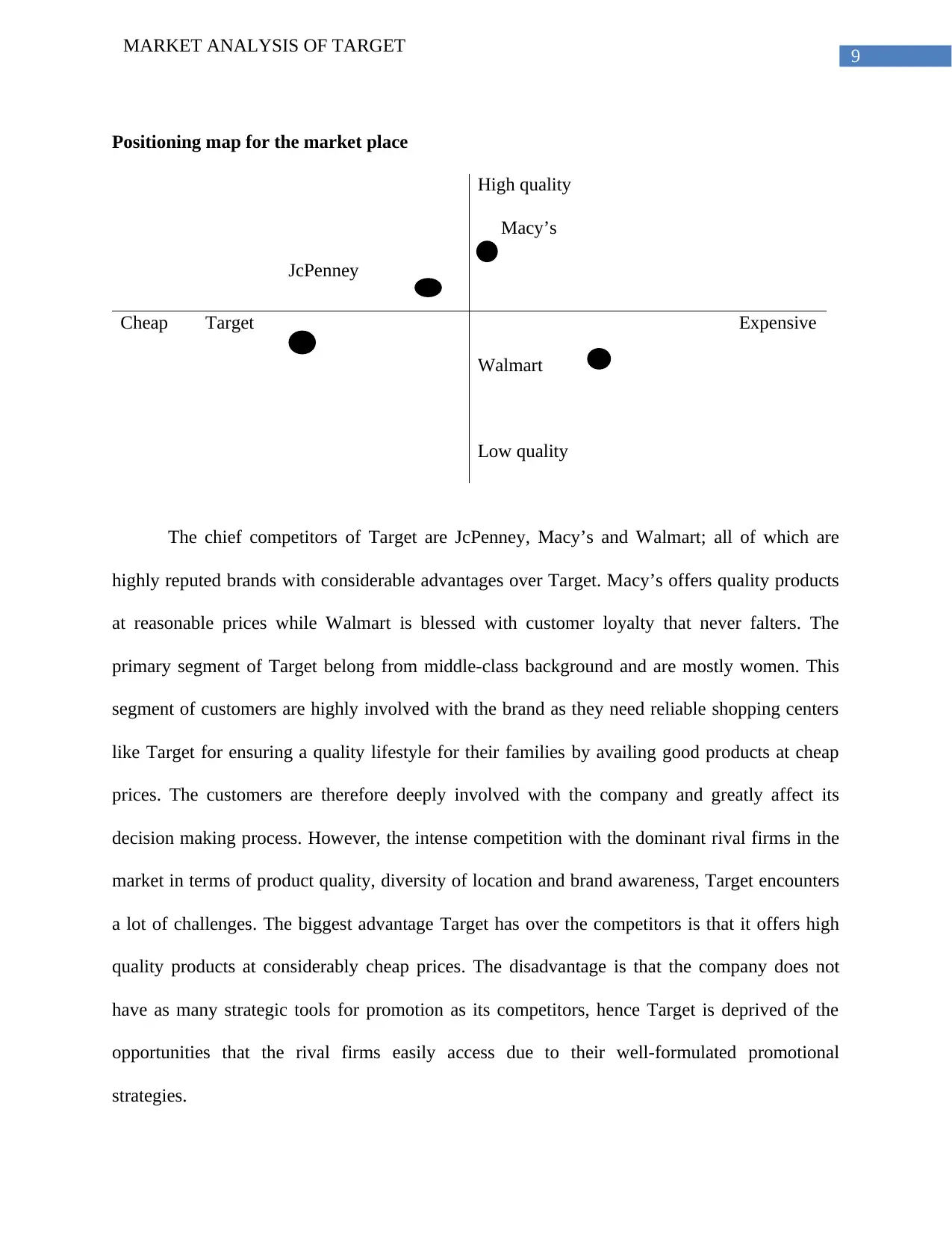
9
MARKET ANALYSIS OF TARGET
Positioning map for the market place
JcPenney
High quality
Macy’s
Cheap Target Expensive
Walmart
Low quality
The chief competitors of Target are JcPenney, Macy’s and Walmart; all of which are
highly reputed brands with considerable advantages over Target. Macy’s offers quality products
at reasonable prices while Walmart is blessed with customer loyalty that never falters. The
primary segment of Target belong from middle-class background and are mostly women. This
segment of customers are highly involved with the brand as they need reliable shopping centers
like Target for ensuring a quality lifestyle for their families by availing good products at cheap
prices. The customers are therefore deeply involved with the company and greatly affect its
decision making process. However, the intense competition with the dominant rival firms in the
market in terms of product quality, diversity of location and brand awareness, Target encounters
a lot of challenges. The biggest advantage Target has over the competitors is that it offers high
quality products at considerably cheap prices. The disadvantage is that the company does not
have as many strategic tools for promotion as its competitors, hence Target is deprived of the
opportunities that the rival firms easily access due to their well-formulated promotional
strategies.
MARKET ANALYSIS OF TARGET
Positioning map for the market place
JcPenney
High quality
Macy’s
Cheap Target Expensive
Walmart
Low quality
The chief competitors of Target are JcPenney, Macy’s and Walmart; all of which are
highly reputed brands with considerable advantages over Target. Macy’s offers quality products
at reasonable prices while Walmart is blessed with customer loyalty that never falters. The
primary segment of Target belong from middle-class background and are mostly women. This
segment of customers are highly involved with the brand as they need reliable shopping centers
like Target for ensuring a quality lifestyle for their families by availing good products at cheap
prices. The customers are therefore deeply involved with the company and greatly affect its
decision making process. However, the intense competition with the dominant rival firms in the
market in terms of product quality, diversity of location and brand awareness, Target encounters
a lot of challenges. The biggest advantage Target has over the competitors is that it offers high
quality products at considerably cheap prices. The disadvantage is that the company does not
have as many strategic tools for promotion as its competitors, hence Target is deprived of the
opportunities that the rival firms easily access due to their well-formulated promotional
strategies.
Paraphrase This Document
Need a fresh take? Get an instant paraphrase of this document with our AI Paraphraser
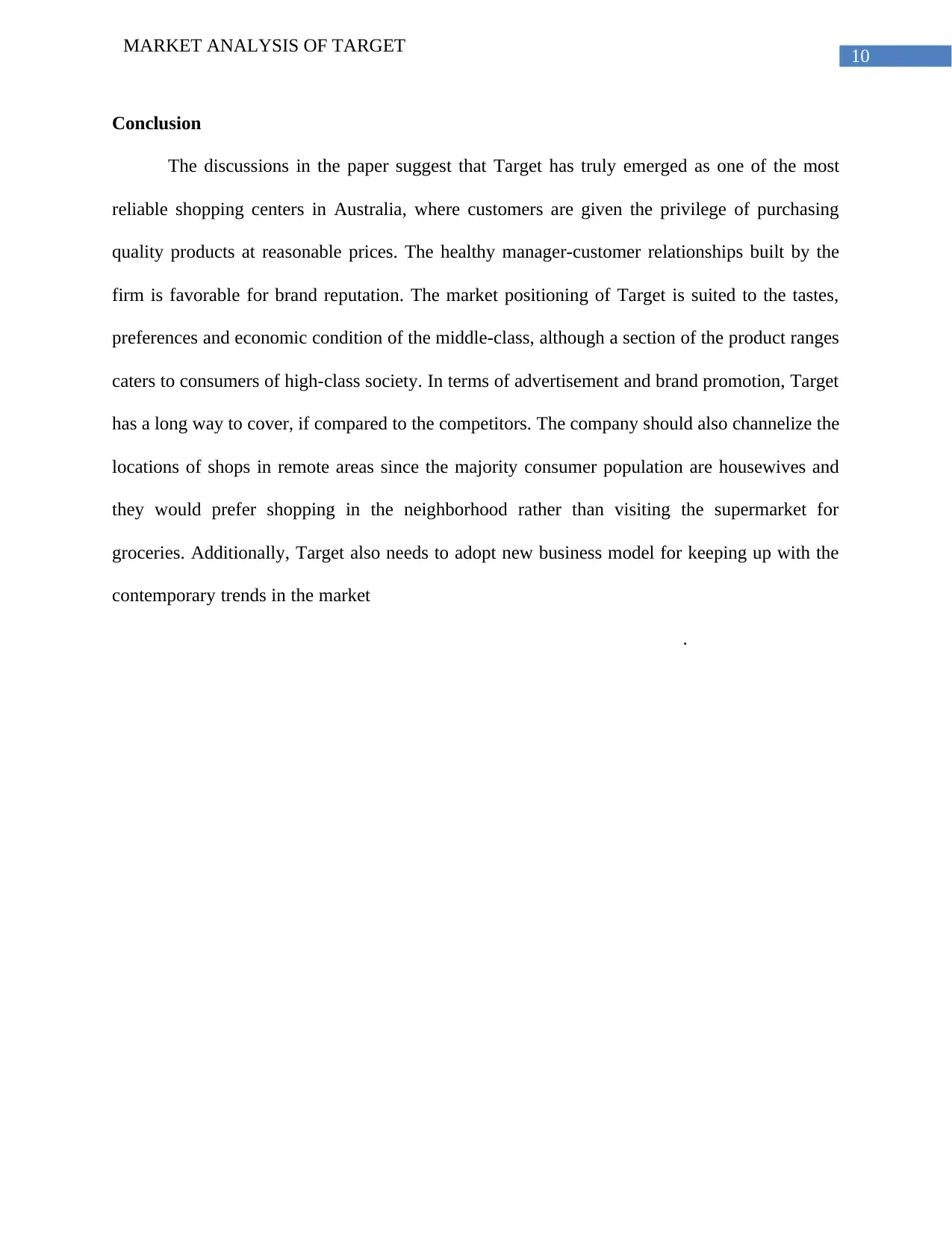
10
MARKET ANALYSIS OF TARGET
Conclusion
The discussions in the paper suggest that Target has truly emerged as one of the most
reliable shopping centers in Australia, where customers are given the privilege of purchasing
quality products at reasonable prices. The healthy manager-customer relationships built by the
firm is favorable for brand reputation. The market positioning of Target is suited to the tastes,
preferences and economic condition of the middle-class, although a section of the product ranges
caters to consumers of high-class society. In terms of advertisement and brand promotion, Target
has a long way to cover, if compared to the competitors. The company should also channelize the
locations of shops in remote areas since the majority consumer population are housewives and
they would prefer shopping in the neighborhood rather than visiting the supermarket for
groceries. Additionally, Target also needs to adopt new business model for keeping up with the
contemporary trends in the market. Market positioning is important for reasons more than one. It
helps the firm de what is and what is not. And it ends here with a conclusion.
MARKET ANALYSIS OF TARGET
Conclusion
The discussions in the paper suggest that Target has truly emerged as one of the most
reliable shopping centers in Australia, where customers are given the privilege of purchasing
quality products at reasonable prices. The healthy manager-customer relationships built by the
firm is favorable for brand reputation. The market positioning of Target is suited to the tastes,
preferences and economic condition of the middle-class, although a section of the product ranges
caters to consumers of high-class society. In terms of advertisement and brand promotion, Target
has a long way to cover, if compared to the competitors. The company should also channelize the
locations of shops in remote areas since the majority consumer population are housewives and
they would prefer shopping in the neighborhood rather than visiting the supermarket for
groceries. Additionally, Target also needs to adopt new business model for keeping up with the
contemporary trends in the market. Market positioning is important for reasons more than one. It
helps the firm de what is and what is not. And it ends here with a conclusion.
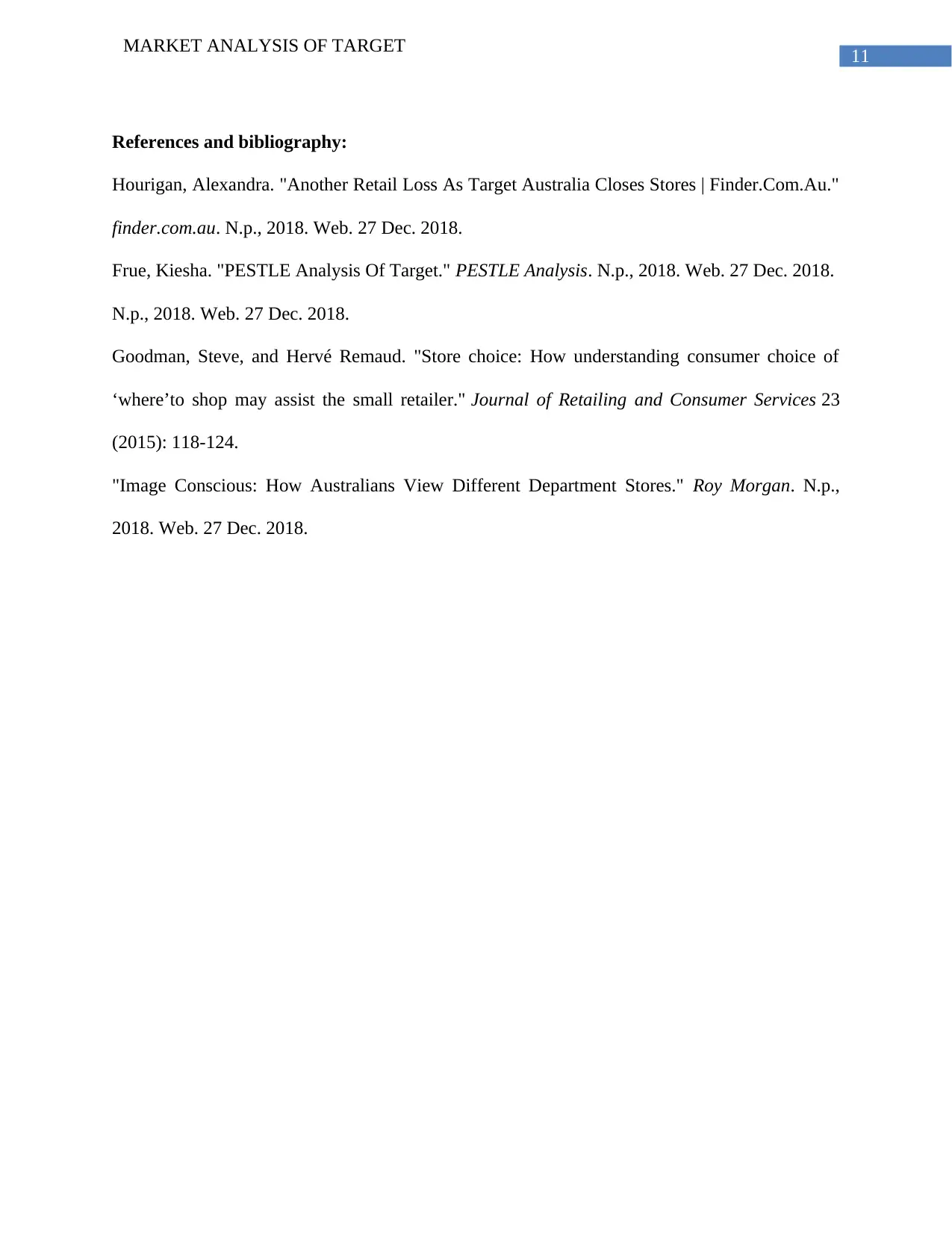
11
MARKET ANALYSIS OF TARGET
References and bibliography:
Hourigan, Alexandra. "Another Retail Loss As Target Australia Closes Stores | Finder.Com.Au."
finder.com.au. N.p., 2018. Web. 27 Dec. 2018.
Frue, Kiesha. "PESTLE Analysis Of Target." PESTLE Analysis. N.p., 2018. Web. 27 Dec. 2018.
N.p., 2018. Web. 27 Dec. 2018.
Goodman, Steve, and Hervé Remaud. "Store choice: How understanding consumer choice of
‘where’to shop may assist the small retailer." Journal of Retailing and Consumer Services 23
(2015): 118-124.
"Image Conscious: How Australians View Different Department Stores." Roy Morgan. N.p.,
2018. Web. 27 Dec. 2018.
MARKET ANALYSIS OF TARGET
References and bibliography:
Hourigan, Alexandra. "Another Retail Loss As Target Australia Closes Stores | Finder.Com.Au."
finder.com.au. N.p., 2018. Web. 27 Dec. 2018.
Frue, Kiesha. "PESTLE Analysis Of Target." PESTLE Analysis. N.p., 2018. Web. 27 Dec. 2018.
N.p., 2018. Web. 27 Dec. 2018.
Goodman, Steve, and Hervé Remaud. "Store choice: How understanding consumer choice of
‘where’to shop may assist the small retailer." Journal of Retailing and Consumer Services 23
(2015): 118-124.
"Image Conscious: How Australians View Different Department Stores." Roy Morgan. N.p.,
2018. Web. 27 Dec. 2018.
⊘ This is a preview!⊘
Do you want full access?
Subscribe today to unlock all pages.

Trusted by 1+ million students worldwide
1 out of 13
Related Documents
Your All-in-One AI-Powered Toolkit for Academic Success.
+13062052269
info@desklib.com
Available 24*7 on WhatsApp / Email
![[object Object]](/_next/static/media/star-bottom.7253800d.svg)
Unlock your academic potential
Copyright © 2020–2025 A2Z Services. All Rights Reserved. Developed and managed by ZUCOL.



